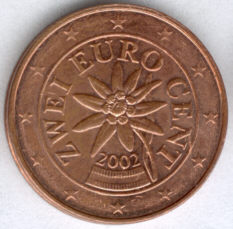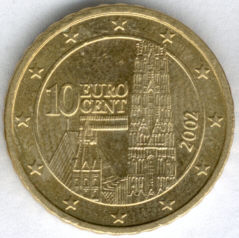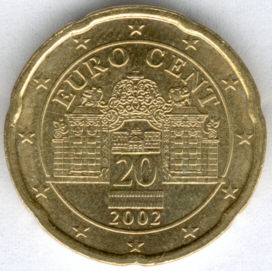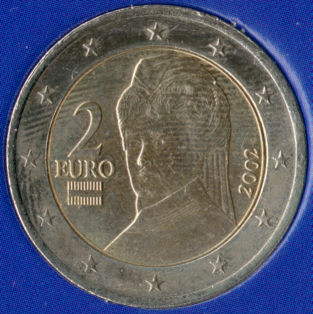








Last modified: 2022-12-27 by martin karner
Keywords: austria | coin | euro |
Links: FOTW homepage |
search |
disclaimer and copyright |
write us |
mirrors

|

|

|
| 1 Euro Cent | 2 Euro Cent | 5 Euro Cent |

|
 |
 |
| 10 Euro Cent | 20 Euro Cent | 50 Euro Cent |

|
 |
|
| 1 Euro | 2 Euro |
Austrian euro coins (all denominations) show a tiny Austrian flag on the country-specific
side. On smaller denominations (1, 2 and 5 cents) the flag is curved upwards so as to fit in the scarce space. Once more, colours are
represented by hatching (three horizontal stripes hatched vertical-plain-vertical standing for red-white-red). Images of the Austrian
euro coins can be found here: http://www.euro.ecb.int/en/section/euro0/specific.AT.html
Santiago Dotor, 21 November 2002
The Austrian flag (heraldically hatched) can be found on all Austrian Euro coins, however in slightly different ways.
10 Cent, 20 Cent, 1 Euro, 2 Euro show the flag in a "straight" version; 1 Cent, 2
Cent, 5 Cent, 50 Cent show it in a curved version.
The proportions also differ somewhat: 2:3 (1 Euro; 2 Euro); 1:3 (10 ct; 20 ct; 50 ct); 2:7 (1 ct; 2 ct; 5
ct).
M. Schmöger, 13 May 2004
At http://www.austrian-mint.com/website/euromuenz.html
the (German language) description says that each Austrian Euro coin contains
"the Austrian colors in heraldic representation." N.b., the term "colors"
("Landesfarben" in the original text) seems to have been used "widely". In other words, the author probably meant the Austrian flag, but wanted to use a
more poetic (?) term. Indeed, the English translation [1] mentions "the red-white-red flag of Austria" and "the Austrian flag." Unfortunately, the
English translation is incomplete, as it omits the references to "heraldic
representation".
Thorsten, 10 May 2004
From http://templates.earthstores.com/1192/proddetail.asp?id=7363616E646D696E74&prod=292171
(including enlargeable images of the coin)
2004 Austria Euro 5 Silver BU Coin "EU Enlargement"
This coin has been issued by the Austrian government to celebrate the May 1 enlargement of the European Union with 10 new countries.
After successfully growing from 6 to 15 members, the European Union is now preparing for its biggest enlargement ever in terms of scope and
diversity. 13 countries have applied to become new members: 10 of these countries -
Cyprus, the Czech Republic, Estonia, Hungary, Latvia, Lithuania, Malta, Poland, the Slovak Republic, and Slovenia are set to join on 1st May 2004.
Bulgaria and Romania hope to do so by 2007, while Turkey is not currently negotiating its membership. In order to join the Union, they need to
fulfill the economic and political conditions known as the 'Copenhagen criteria', according to which a prospective member must be a stable
democracy, respecting human rights, the rule of law, and the protection of
minorities; have a functioning market economy; and adopt the common rules, standards and policies that make up the body of EU law.
The coin’s reverse features a map of Europe with the location of the ten new countries marked by flags, and their official names in the native
language toward the bottom. The legend to the left says “EU Erweiterung 2004” and to the right of the legend is the new hallmark for Euro issues –
a Euro sign inside a star - this year featured on coins from Austria, Holland, France, Belgium, Spain and Portugal (more countries will adopt the
hallmark in 2005). The obverse shows the shields of the 9 Austrian provinces – corresponding also to the edges of the coin itself – as well as
the legend “Republik Österreich”, the denomination in the middle, and
“Euro” at the bottom.
The coin has been struck by the Austrian Mint in 80% silver, and measures 28.50 mm in diameter and weighs 8 grams. The issue limit is 100,000 coins
of the brilliant uncirculated version, and it comes delivered mounted in a colorful and informative
folder.
spotted by Lewis A. Nowitz, 9 May 2004